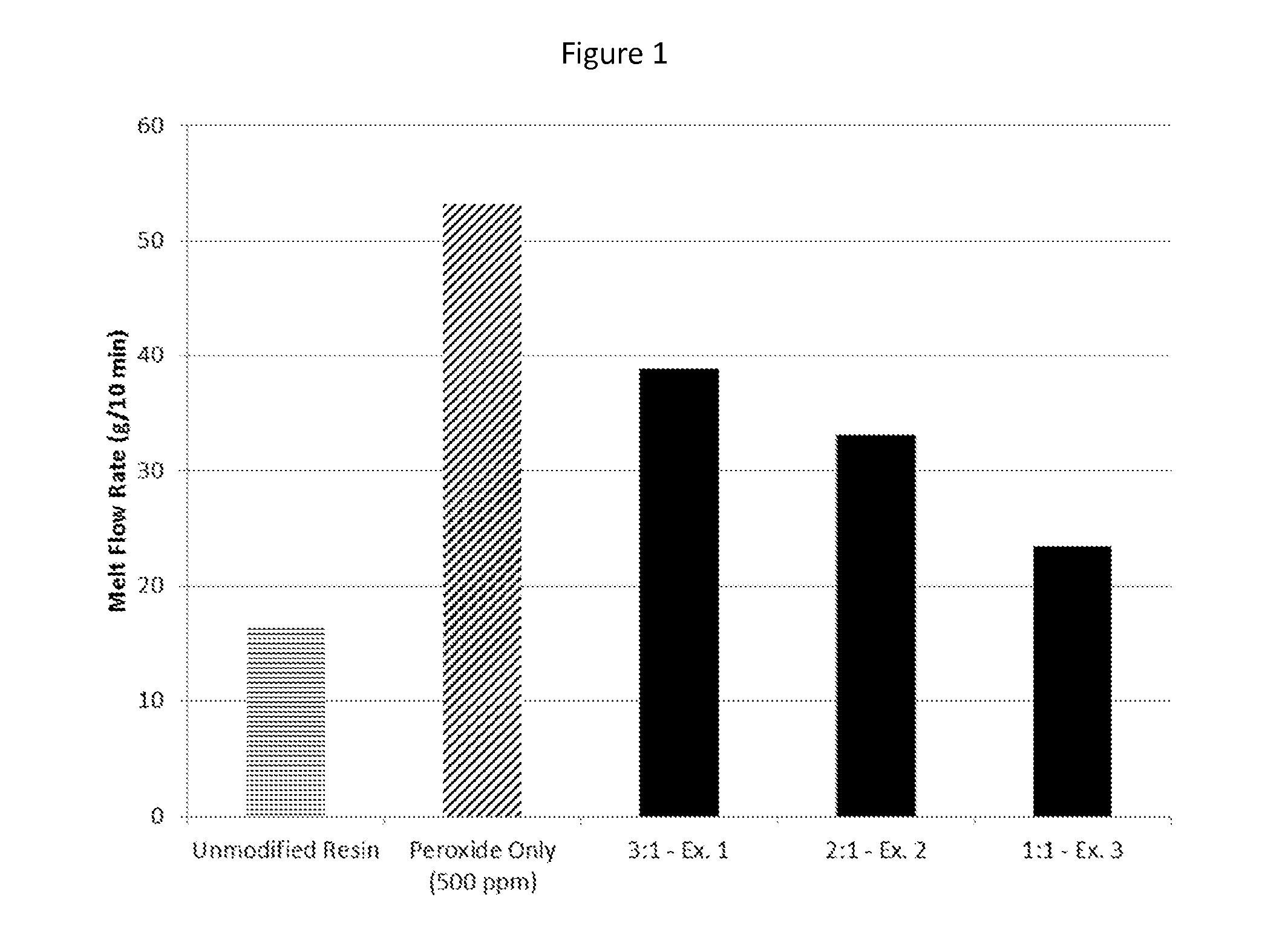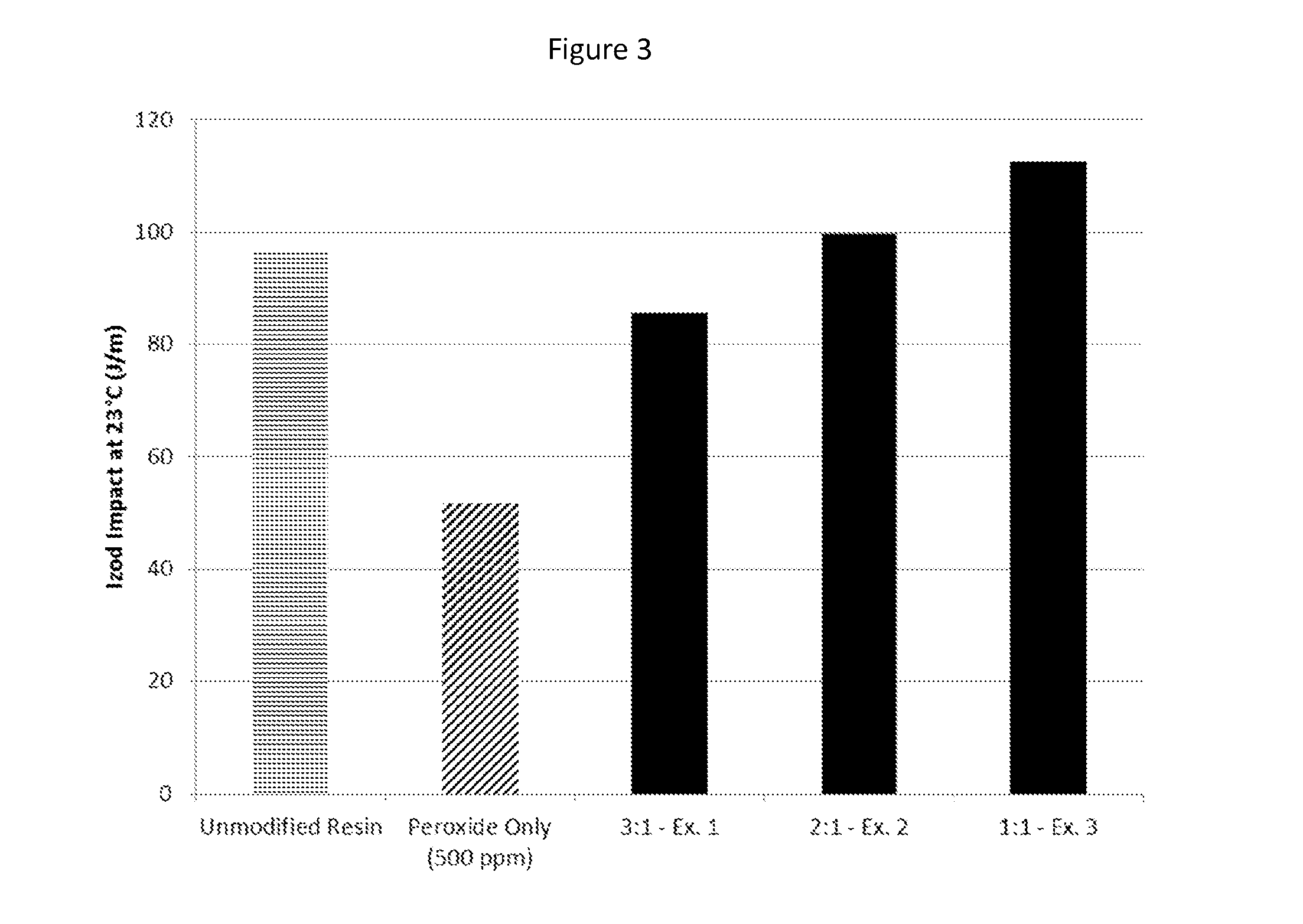Modified heterophasic polyolefin composition
a polyolefin composition and heterophasic technology, applied in the field can solve the problems of reducing the impact performance of heterophasic polyolefin compositions, their relatively low melt flow rate, etc., and achieves the effect of reducing the impact performance, high impact strength, and low melt flow ra
- Summary
- Abstract
- Description
- Claims
- Application Information
AI Technical Summary
Benefits of technology
Problems solved by technology
Method used
Image
Examples
examples
[0049]The following examples further illustrate the subject matter described above but, of course, should not be construed as in any way limiting the scope thereof. The following methods, unless noted, were used to determine the properties described in the following examples.
[0050]Each of the compositions was compounded by blending the components in a closed container for approximately one minute. The compositions were then melt compounded on a Prism TSE-16-TC co-rotating, fully intermeshing, parallel, twin-screw extruder with a 16 mm screw diameter and a length / diameter ratio of 25:1. The barrel temperature of the extruder was ramped from approximately 195° C. to approximately 215° C., and the screw speed was set at approximately 500 rpm. The extrudate (in the form of a strand) for each polypropylene copolymer composition was cooled in a water bath and subsequently pelletized.
[0051]The pelletized compositions were then used to form bars by injection molding the compositions on a Ni...
examples 1-6
[0056]The following examples demonstrate the modification of a heterophasic polyolefin composition and performance enhancements achieved, according to the method of the present invention.
[0057]The compatibilizing agent was melt compounded into batches of a heterophasic polypropylene copolymer in accordance with the general formulation set forth in Table 1.
TABLE 1Heterophasic polypropylene copolymer formulationsComponentLoadingPolypropylene copolymer (LyondellBasellBalancePro-Fax SD375S with approximately 19%xylene solubles)Primary antioxidant (Irganox ® 1010)500 ppmSecondary antioxidant (Irgafos ® 168)1000 ppm Acid scavenger (calcium stearate)800 ppmPeroxide (Varox DBPH)See Table 2Additive (Compatibilizing Agent)See Table 2Irganox ® 1010 is available from BASFIrgafos ® 168 is available from BASFVarox DBPH is an organic peroxide available from R.T. Vanderbilt Company
[0058]Each of the compositions listed in Table 2 was mixed, extruded, and injection molded according to the above proce...
example 17
[0076]The following examples demonstrate the production of a modified heterophasic polyolefin composition, created by melt mixing a polypropylene homopolymer, a polyolefin elastomer, an organic peroxide and the compatibilizing agent of the present invention. In particular, a 2 dg / min polypropylene homopolymer (Total Petrochemicals 3276), 20 w / w % of a polyolefin elastomer (Engage™ 7467 from The Dow Chemical Company), an organic peroxide (Varox DBPH available from R.T. Vanderbilt Company) and TEMPO-methacrylate (Sigma-Aldrich) were melt mixed and tested. The results were compared to the heterophasic polyolefin composition created when peroxide only was present and when neither the peroxide nor the compatibilizing agent were present.
[0077]The loadings of the initiator and TEMPO methacrylate are listed in Table 10. Each of the polymer blend compositions was mixed, extruded, and injection molded according to the above procedure. The bars were then subjected to melt flow rate and Izod im...
PUM
| Property | Measurement | Unit |
|---|---|---|
| pressure | aaaaa | aaaaa |
| weight % | aaaaa | aaaaa |
| weight % | aaaaa | aaaaa |
Abstract
Description
Claims
Application Information
 Login to View More
Login to View More - R&D
- Intellectual Property
- Life Sciences
- Materials
- Tech Scout
- Unparalleled Data Quality
- Higher Quality Content
- 60% Fewer Hallucinations
Browse by: Latest US Patents, China's latest patents, Technical Efficacy Thesaurus, Application Domain, Technology Topic, Popular Technical Reports.
© 2025 PatSnap. All rights reserved.Legal|Privacy policy|Modern Slavery Act Transparency Statement|Sitemap|About US| Contact US: help@patsnap.com



